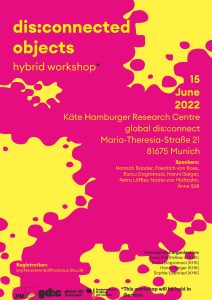15 Jun 22, hybrid workshop: dis:connected objects

In the process of globalisation, which develops not only as a form of intensifying networks and a compression of geographical connection but equally as a site of missing or missed connections and disentanglement, objects play an ambivalent role. On the one hand, they are viewed as symbols and metaphors for a world seemingly shrinking in size (such as the computer and technologies connected with it that facilitate connections worldwide). On the other, they can stand for the severe breaks, absences, detours and interruptions that are intrinsically linked to processes of globalisation, migration and exile (such as beloved family photographs that are brought into exile but also lost, dispersed and destroyed on migration routes).
Building on and expanding research on the provenance and restitution of objects, which has discussed ethical and legal issues connected to objects that were (illegally) transferred and sold under conditions of political dominance and exploitation, we would like to focus on the objects themselves. How are they dealt with in the context of museums? How do they reflect, change, challenge and deconstruct our undertanding of globalisation?
Our workshop would like to shift attention to the processes of dis:connectivities in globalisation and how they impress themselves onto individual objects, their uses (or non-use) and functions in aesthetic and/or social as well as historical domains. How do objects stand in for the absences and detours that are also the result of globalisation? How are (art) objects dealt with in museum contexts that feature discourses about globalisation, migration and exile? What functions do objects have in debates about the political, historical and contemporary ‘dangers‘ of globalisation, migration and exile? Taking individual objects as our starting point, we would like to discuss how objects and the discourses connected to them negotiate the reciprocal, but also tension-laden, relationships of global dis:entanglements? How do objects provide a complex, ambivalent or even controversial interface for the complex processes of globalisation?
Please note that the workshop will be held in German. You can find the full programme HERE.
Concept and organisation:
Änne Söll (Fellow at global dis:connect)
Burcu Dogramaci (global dis:connect)
Hanni Geiger (global dis:connect)
Sophie Eisenried (global dis:connect)





